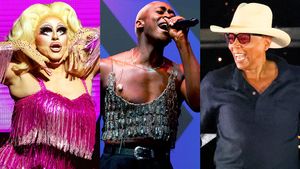Beloved lesbian author (Oranges Are Not the Only Fruit) Jeanette Winterson's latest novel Frankissstein is a retelling of both Mary Shelley's classic monster tale Frankenstein and of its creation. Frankissstein bounces through time, paralleling a retelling of the moment Shelley brings her story to life in 1816 with a tale from a post-Brexit Britain in which a scientist attempts to reanimate human body parts.
Winterson is also examining the creative process of writing and its similarities to the undertaking of Victor Frankenstein as he throws a switch and life surges into what was previously inanimate, stitched-together parts from various corpses. The author herself is grave-robbing here by reviving a 200-year-old horror story rather than crafting a wholly original tale.
In Frankissstein, Shelley's story gets away from her. It takes on a life of its own and the "monster" breaks free from the boundaries of her novel to haunt the real world. In Winterson's telling, Shelley's novel has another unintended consequence -- driving the real Dr. Victor Frankenstein insane. Confined to Britain's infamous Bedlam asylum, the doctor that Mary Shelley based her Dr. Frankenstein on is suffering from the delusion that he is nothing but a character in a novel, a creation of Shelley's imagination.
How real are any of us? How solid is our sense of self? What makes you you? Would you still be you if your essence was somehow distilled into sequences of ones and zeroes? These are the questions that Winterson poses in Frankissstein.
Of course, in Shelley's novel the real monster is not the lumbering yet gentle giant but the bigotry of small-minded townsfolk who become bent on wiping the "abomination" -- that they fear out of ignorance -- from the earth.
Given the way the LGBTQ community has itself been labeled an abomination and murdered by those policing the boundaries of sexuality and gender, it's not surprising that Winterson would be drawn to Frankenstein. In it, she finds fertile ground for a contemplation on the nature of gender and humanity in a modern world that seems to be vacillating between the horrors of climate crisis and a future in which we have conquered death, created life (in the form of independent artificial intelligence), and developed transhuman cyborgs or uploaded human consciousness to the web.
The modern elements of the book include characters who mirror those present at the creation of Frankenstein: Mary Shelley and her husband (poet Percy Bysshe Shelley) are combined into the queer transgender nonbinary surgeon Ry Shelley, around whom the story coalesces; the misogynist poet Lord Byron is recast as a boorish sex-bot king, Ron Lord; physician John William Polidori becomes Vanity Fair reporter Polly D.; and Mary's stepsister, Claire, morphs into an American Claire, who is more engaging and animated than the original but shares her namesake's questionable taste in men (they each fall for their Lord). In the 21st century, Victor Stein isn't a literary creation of Ry Shelley's but makes his appearance in the flesh as their lover, a transhumanist scientist eager to free humanity from the limits of flesh.
Stein imagines a utopia where artificial intelligence frees us of our sexist and homophobic or transphobic biases (despite real world research suggesting that AI learns our bigotries). Meanwhile, Lord imagines harnessing technology to make an army of sex bots to relieve horny men of ethical or moral hesitations. Just want to keep a woman around to fill her holes? Lord has a bot for that -- it won't talk back and folds up nicely. Want to bang young boys? Lord can imagine a bot for that, one that could solve pesky problems facing the Catholic Church.
The latter suggestion arises from an unusual pairing that finds Lord in bed (romantically and financially) with the evangelical Christian Claire. These bedmates seem as unlikely as, say, evangelicals embracing Donald Trump -- but given the right incentive, apparently morality is relative.
One can easily imagine Frankissstein adapted as a film alternating between erotically charged (queer) sex scenes, action escape sequences, slapstick comedy (the unfolding of a dirty-mouthed sex bot during a hoity-toity shindig), and unsettling images (a horde of disembodied hands swarm around like those Minority Report spiders).
There is a cinematic climax, too, but questions remain: Was Victor Stein who he said he was? Did he really revive a dead man? When we are mere characters in a story created by someone else, Winterson seems to imply, we cannot read the ending. Nor can we predict the future.


















































































Fans thirsting over Chris Colfer's sexy new muscles for Coachella